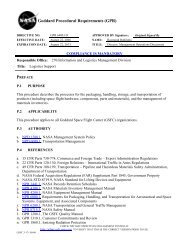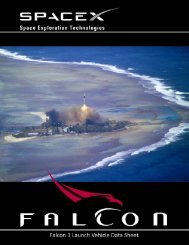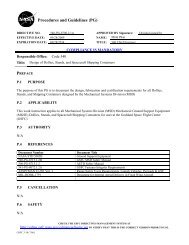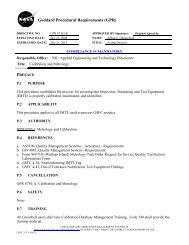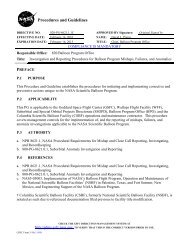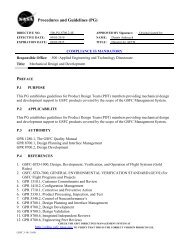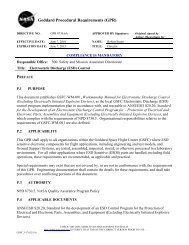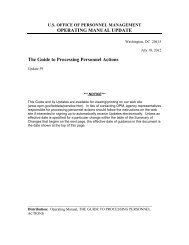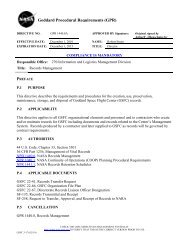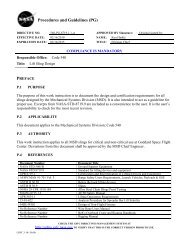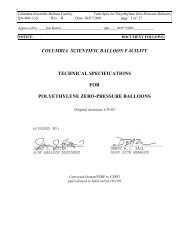800-PG-8621.0.1 - FOIA and eLibrary website! - NASA
800-PG-8621.0.1 - FOIA and eLibrary website! - NASA
800-PG-8621.0.1 - FOIA and eLibrary website! - NASA
You also want an ePaper? Increase the reach of your titles
YUMPU automatically turns print PDFs into web optimized ePapers that Google loves.
Procedures <strong>and</strong> Guidelines (<strong>PG</strong>)<br />
DIRECTIVE NO. <strong>800</strong>-<strong>PG</strong>-<strong>8621.0.1</strong> APPROVED BY Signature: Original Signed by<br />
EFFECTIVE DATE: September 10, 2009 NAME: John H. Campbell<br />
EXPIRATION DATE: September 10, 2014 TITLE: Director of Suborbital & Special Orbital<br />
Projects<br />
COMPLIANCE IS MANDATORY<br />
Responsible Office: <strong>800</strong>/Suborbital <strong>and</strong> Special Orbital Projects Directorate<br />
Title: Suborbital Anomaly Investigation <strong>and</strong> Reporting<br />
PREFACE<br />
P.1 PURPOSE<br />
This directive establishes the procedure for anomaly investigation <strong>and</strong> reporting <strong>and</strong> the process for<br />
establishing an Anomaly Review Board (ARB) when one or more of the accepted risks occurs <strong>and</strong><br />
causes a mission failure or degradation in performance.<br />
Any failure or anomaly that causes significant injury or death of participating or non participating<br />
personnel or significant damage to any <strong>NASA</strong> or non-<strong>NASA</strong> equipment or facilities that was not in the<br />
acceptable risk list will be investigated through the Mishap Investigation Board (MIB) process found in<br />
NPR 8621.1, Mishap Reporting, Investigating, <strong>and</strong> Recordkeeping.<br />
P.2 APPLICABILITY<br />
This directive is applicable to suborbital projects managed by the Wallops Flight Facility (WFF) <strong>and</strong> the<br />
research <strong>and</strong> development (R&D) based projects conducted from or under the auspices of the WFF<br />
Research Range.<br />
Based on the risk posture of suborbital programs, these projects are conducted while knowingly<br />
accepting many risks that an orbital mission may not accept. The Suborbital Program at WFF includes<br />
sounding rockets, scientific balloons, <strong>and</strong> unpiloted aircraft missions. The Suborbital Program is funded<br />
through research <strong>and</strong> technologies <strong>and</strong> as such is managed under NPR 7120.8, <strong>NASA</strong> Research <strong>and</strong><br />
Technology Program <strong>and</strong> Project Management Requirements.<br />
The WFF Research Range supports projects of many types: orbital launches, sounding rockets,<br />
technology demonstrations, advanced technology flights. In support of the projects, the range has<br />
inherent risks that are mitigated to the maximum extent then accepted as residual risks to the project. As<br />
with the suborbital programs if the project/mission fails to achieve comprehensive success due to one of<br />
the accepted range risks, the anomaly process described in Section 2.0 will be implemented.<br />
CHECK THE GSFC DIRECTIVES MANAGEMENT SYSTEM AT<br />
http://gdms.gsfc.nasa.gov/gdmsnew/home.jsp TO VERIFY THAT THIS IS THE CORRECT VERSION PRIOR TO USE.<br />
GSFC 3-18 (7/06)
DIRECTIVE NO. <strong>800</strong>-<strong>PG</strong>-<strong>8621.0.1</strong> Page 2 of 2<br />
EFFECTIVE DATE: September 10, 2009<br />
EXPIRATION DATE: September 10, 2014<br />
P.3 AUTHORITY<br />
NPR 8621.1, Mishap Reporting, Investigating, <strong>and</strong> Recordkeeping<br />
GPR 8621.3, Mishap <strong>and</strong> Close Call Investigation<br />
P.4 REFERENCES<br />
NPR 7120.8, <strong>NASA</strong> Research <strong>and</strong> Technology Program <strong>and</strong> Project Management Requirements<br />
NPR 8621.1, Mishap Reporting, Investigating, <strong>and</strong> Recordkeeping<br />
P.5 CANCELLATION<br />
N/A<br />
P.6 SAFETY<br />
N/A<br />
P.7 TRAINING<br />
N/A<br />
P.8 RECORDS<br />
Record Title Record Custodian Retention<br />
Program Accepted Risks List Program Office *NRRS 8/107, Temporary.<br />
Destroy/delete between 5 <strong>and</strong> 30<br />
years after program/project<br />
termination.<br />
Project Plans Program Office *NRRS 8/107<br />
Anomaly Review Board Charter/Appointment<br />
Memor<strong>and</strong>um<br />
Program Office *NRRS 8/107<br />
Anomaly Review Board Final Report Program Office *NRRS 8/107<br />
Program Office Response Program Office *NRRS 8/107<br />
Program Office conformation of acceptable risk<br />
as the most likely cause of a failure<br />
Program Office *NRRS 8/107<br />
* NRRS – <strong>NASA</strong> Records Retention Schedule (NPR 1441.1)<br />
CHECK THE GSFC DIRECTIVES MANAGEMENT SYSTEM AT<br />
http://gdms.gsfc.nasa.gov/gdmsnew/home.jsp TO VERIFY THAT THIS IS THE CORRECT VERSION PRIOR TO USE.<br />
GSFC 3-18 (7/06)
DIRECTIVE NO. <strong>800</strong>-<strong>PG</strong>-<strong>8621.0.1</strong> Page 3 of 3<br />
EFFECTIVE DATE: September 10, 2009<br />
EXPIRATION DATE: September 10, 2014<br />
P.9 METRICS<br />
N/A<br />
P.10 DEFINITIONS<br />
a. Accepted Risk – the risk that is understood <strong>and</strong> agreed to by the program/project, governing PMC,<br />
Mission Directorate, <strong>and</strong> other customer(s) such that no further specific mitigating action is required.<br />
b. Anomaly - any isolated accident, failure, or event that results in damage to flight hardware or could<br />
cause a significant schedule slip, significant cost growth, inability to meet mission requirements,<br />
<strong>and</strong>/or inability to transmit or process data.<br />
c. Risk Posture – denotes the amount of risk a program can accept while still meeting <strong>NASA</strong> program<br />
requirements.<br />
d. Residual Risks – risks that remain after all reasonable mitigation actions have been applied.<br />
P.11 ACRONYMS<br />
AETD<br />
ARB<br />
MIB<br />
PI<br />
PM<br />
PMC<br />
R&D<br />
SSOPD<br />
WFF<br />
Applied Engineering <strong>and</strong> Technology Directorate<br />
Anomaly Review Board<br />
Mishap Investigation Board<br />
Principal Investigator<br />
Project Manager<br />
Program Management Council<br />
Research <strong>and</strong> Development<br />
Suborbital <strong>and</strong> Special Orbital Projects Directorate<br />
Wallops Flight Facility<br />
PROCEDURES<br />
In this document, a requirement is identified by “shall,” a good practice by “should,” permission by<br />
“may” or “can,” expectation by “will,” <strong>and</strong> descriptive material by “is.”<br />
1.0 Risk<br />
It is the responsibility of each Suborbital Program Office to establish <strong>and</strong> document the accepted risks<br />
for their Program. These acceptable risks will be the basis for risk acceptance for each of the<br />
missions/projects conducted by the program office except as noted in the individual project/mission<br />
plans. Individual projects within the portfolio may choose to accept more or less risk depending on the<br />
customer being supported. The customer will acknowledge acceptance of these risk via signature on the<br />
project/mission plan.<br />
CHECK THE GSFC DIRECTIVES MANAGEMENT SYSTEM AT<br />
http://gdms.gsfc.nasa.gov/gdmsnew/home.jsp TO VERIFY THAT THIS IS THE CORRECT VERSION PRIOR TO USE.<br />
GSFC 3-18 (7/06)
DIRECTIVE NO. <strong>800</strong>-<strong>PG</strong>-<strong>8621.0.1</strong> Page 4 of 4<br />
EFFECTIVE DATE: September 10, 2009<br />
EXPIRATION DATE: September 10, 2014<br />
For each project conducted by the WFF Research Range the accepted risks shall be documented in the<br />
project plan <strong>and</strong> updated as required. The customer or principal investigator <strong>and</strong> the Project Manager<br />
(PM) will show concurrence by signatures on the project plan <strong>and</strong> on any revisions.<br />
2.0 Appointment of ARB<br />
When a project/mission anomaly takes place due to one or more of the accepted risks occurring, which<br />
causes the project to not obtain at least minimum success requirements, the Program Office Chief will<br />
appoint (by charter memor<strong>and</strong>um with concurrence from the Director of Suborbital <strong>and</strong> Special Orbital<br />
Projects Directorate (SSOPD), an independent anomaly review board (ARB). The chair of the ARB will<br />
be from the WFF Applied Engineering <strong>and</strong> Technology Directorate (AETD). The remainder of the<br />
board members shall be comprised of qualified civil servants <strong>and</strong> contractors. The board shall consist of<br />
a minimum of three members plus an executive secretary. The executive secretary shall be someone<br />
without an engineering or science (technical) background responsible for scheduling meetings, note<br />
taking, production of the final report, etc. The Program Office Chiefs (appointing officials) are<br />
encouraged to add a board member with little or no experience in the investigation process. This will<br />
allow for more employees to learn about our programs <strong>and</strong> processes. The Program Office shall provide<br />
support <strong>and</strong> consultation to the ARB as required.<br />
3.0 ARB Reporting<br />
If the ARB determines that the suspected anomaly was not due to an accepted risk then the normal MIB<br />
process (NPR 8621.1) will be implemented at the earliest possible date.<br />
The ARB interim <strong>and</strong> final reports will be delivered to Program Office Chief for approval. The final<br />
report shall be delivered approximately 4 weeks from the date of the approved charter. The affected<br />
Program Office shall provide a briefing to the Director of SSOPD which will include the review board<br />
findings, office response, <strong>and</strong> corrective action(s).<br />
When a Principal Investigator’s (PI) supplied payload/instrument fails to perform to acceptable<br />
st<strong>and</strong>ards this is considered a st<strong>and</strong>ard accepted risk for the suborbital programs. In this case, the PI will<br />
be tasked to perform the anomaly review <strong>and</strong> provide a final report to the supporting program office.<br />
The Program Office will review these reports to determine if any action is required by the office.<br />
4.0 Anomaly Notification<br />
When a failure occurs as the result of an accepted risk the following notification chain will be<br />
implemented:<br />
a. Project Manager<br />
b. Program Office Lead<br />
c. Director of SSOPD<br />
d. Safety Office Chief<br />
e. Program Executive<br />
f. Program Scientist<br />
g. Center Deputy Director<br />
h. Center Director<br />
5.0 Investigation Guidelines<br />
CHECK THE GSFC DIRECTIVES MANAGEMENT SYSTEM AT<br />
http://gdms.gsfc.nasa.gov/gdmsnew/home.jsp TO VERIFY THAT THIS IS THE CORRECT VERSION PRIOR TO USE.<br />
GSFC 3-18 (7/06)
DIRECTIVE NO. <strong>800</strong>-<strong>PG</strong>-<strong>8621.0.1</strong> Page 5 of 5<br />
EFFECTIVE DATE: September 10, 2009<br />
EXPIRATION DATE: September 10, 2014<br />
Below are minimum investigation guidelines of the typical/generic things to consider in the<br />
investigation process. These guidelines can be tailored for the specific anomaly.<br />
a. Narrative description of the facts including what, when, <strong>and</strong> where.<br />
b. Description explaining why the incident occurred including all findings(s) such as proximate<br />
cause(s), root cause(s), contributing factors(s), <strong>and</strong> the evidence upon which the findings are based.<br />
c. Description of the type of data gathered <strong>and</strong> evaluated during the investigation.<br />
d. An executive summary that does not contain privileged or proprietary information, material subject<br />
to the Privacy Act, ITAR information, or EAR<br />
e. Conclusions <strong>and</strong> recommendations to prevent recurrence.<br />
f. A list of advisor(s) signatures demonstrating that he/she has reviewed the mishap report that any<br />
privileged or proprietary information, ITAR information, EAR information, or material subject to<br />
the Privacy Act has been identified <strong>and</strong> marked as nonreleasable to the public; <strong>and</strong> that sections that<br />
are releasable to the public are marked releasable <strong>and</strong>, to the best of his/her knowledge, are ready for<br />
public release.<br />
g. Investigating authority signature demonstrating their approval of the mishap report. (Same person<br />
who assigned the investigation).<br />
h. Minority report from any person, if there is one.<br />
CHECK THE GSFC DIRECTIVES MANAGEMENT SYSTEM AT<br />
http://gdms.gsfc.nasa.gov/gdmsnew/home.jsp TO VERIFY THAT THIS IS THE CORRECT VERSION PRIOR TO USE.<br />
GSFC 3-18 (7/06)
DIRECTIVE NO. <strong>800</strong>-<strong>PG</strong>-<strong>8621.0.1</strong> Page 6 of 6<br />
EFFECTIVE DATE: September 10, 2009<br />
EXPIRATION DATE: September 10, 2014<br />
CHANGE HISTORY LOG<br />
Revision Effective Date Description of Changes<br />
Baseline 9/10/2009 Initial Release<br />
CHECK THE GSFC DIRECTIVES MANAGEMENT SYSTEM AT<br />
http://gdms.gsfc.nasa.gov/gdmsnew/home.jsp TO VERIFY THAT THIS IS THE CORRECT VERSION PRIOR TO USE.<br />
GSFC 3-18 (7/06)



